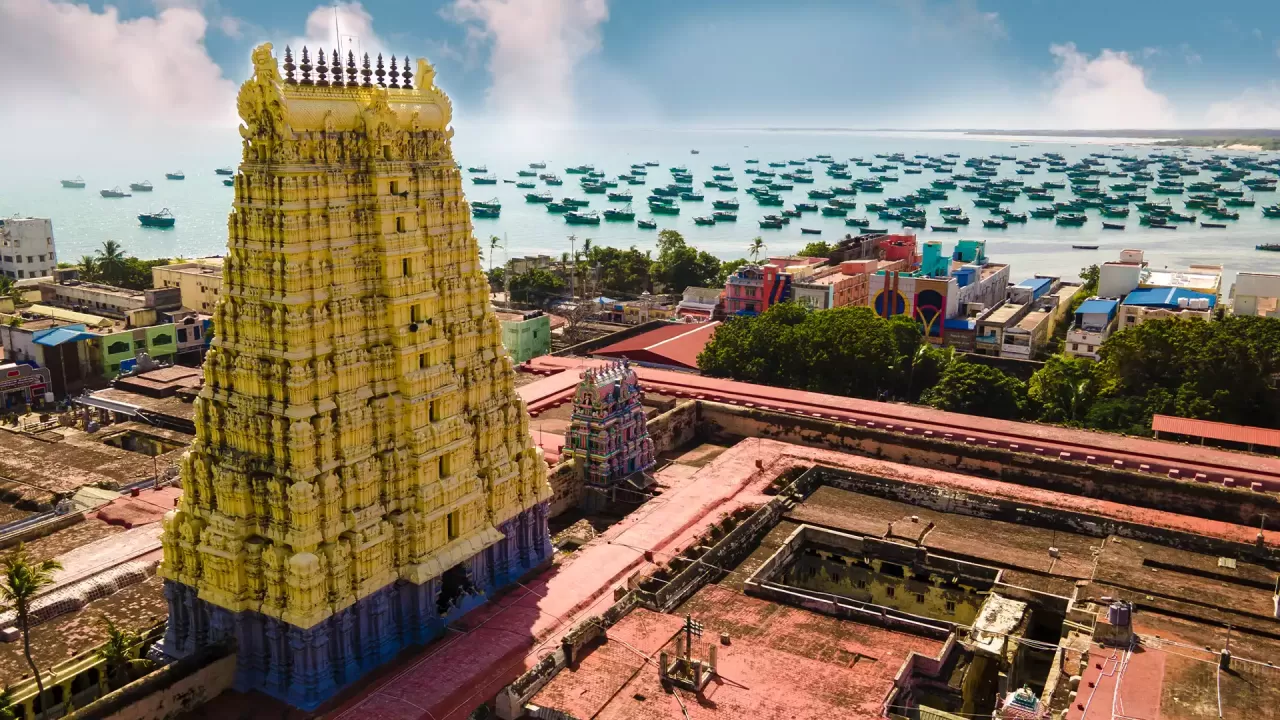Rameshwaram, a small island town in Tamil Nadu, India, is one of the holiest places in Hinduism, steeped in mythology, spirituality, and history. It is renowned for its ancient temples, pristine beaches, and the famous Ramanathaswamy Temple, which holds great significance for devotees of Lord Shiva. One of the most profound and spiritually uplifting rituals performed in this temple is the Rudrabhishek Puja. This article explores the significance, rituals, and the spiritual essence of Rudrabhishek Puja in Rameshwaram, offering a glimpse into the divine experience that draws pilgrims from all over the world.
The Spiritual Significance of Rameshwaram
Rameshwaram is not just another pilgrimage site; it is a place where divinity meets devotion. According to Hindu mythology, Rameshwaram is the place where Lord Rama, the seventh incarnation of Lord Vishnu, built a bridge (Rama Setu) across the sea to Lanka to rescue his wife, Sita, from the demon king Ravana. After his victory, Lord Rama returned to Rameshwaram and installed a Shiva Lingam to atone for the sin of killing Ravana, who was a Brahmin. The Ramanathaswamy Temple, which houses this sacred Lingam, is one of the twelve Jyotirlingas, the most revered shrines of Lord Shiva.
The temple's significance is further enhanced by the belief that a pilgrimage to Varanasi, another sacred city, is incomplete without visiting Rameshwaram. Thus, Rameshwaram holds a unique place in the hearts of Hindu devotees, symbolizing the confluence of Lord Vishnu and Lord Shiva's divine energies.
Understanding Rudrabhishek Puja
Rudrabhishek Puja is a powerful Vedic ritual dedicated to Lord Shiva. The term "Rudra" refers to Lord Shiva in his fierce form, and "Abhishek" means a ritualistic offering or bath. Therefore, Rudrabhishek is the ceremonial bath of the Shiva Lingam with sacred substances while chanting Vedic mantras, particularly the Rudram, a hymn dedicated to Lord Shiva from the Yajurveda.
The ritual is considered one of the most effective means of invoking Lord Shiva's blessings. It is believed to cleanse the mind, body, and soul of the devotee, remove negative energies, and fulfill desires. Moreover, Rudrabhishek Puja is said to appease the planetary deities, especially when performed to mitigate the effects of Shani (Saturn) or other malefic planets in one's horoscope.
The Process of Rudrabhishek Puja in Rameshwaram
The Rudrabhishek Puja in Rameshwaram is a meticulously conducted ritual, typically performed by highly trained priests within the sanctum sanctorum of the Ramanathaswamy Temple. The Puja begins early in the morning and can be performed individually or in a group.
-
Preparation and Purification: The first step in the Puja involves purifying the devotees and the surroundings. Devotees take a dip in the sacred Agni Theertham, a sea located close to the temple, believed to purify sins and bring spiritual elevation. The priests also prepare by purifying themselves and the temple space through prayers and rituals.
-
Sankalpam: After purification, the devotee makes a sankalpam, or vow, expressing their intention and devotion to performing the Puja. This step is crucial as it aligns the devotee's mind with the divine purpose of the ritual.
-
Invocation of Lord Shiva: The main ritual begins with the invocation of Lord Shiva by chanting the Rudram, a sacred mantra that glorifies the various aspects of Lord Shiva. The chanting is melodious and rhythmic, creating a powerful and serene atmosphere.
-
Abhishek (Offering): The Shiva Lingam is bathed with a series of sacred substances, each with its symbolic significance:
- Water: Represents purity and is the basic element used in the Abhishek.
- Milk: Symbolizes nourishment and the fostering of life.
- Curd (Yogurt): Represents prosperity and progeny.
- Honey: Signifies sweetness in life and removes bitterness.
- Ghee (Clarified Butter): Symbolizes strength and victory.
- Coconut Water: Represents the fulfillment of desires.
- Sugarcane Juice: Signifies the sweetness of speech and harmonious relationships.
- Panchamrit: A mixture of milk, curd, honey, ghee, and sugar, used as a final offering.
Each of these offerings is poured over the Lingam while chanting specific mantras, invoking the blessings of Lord Shiva.
-
Offering Bilva Leaves: The ritual continues with the offering of Bilva leaves, which are considered extremely auspicious and dear to Lord Shiva. The tri-foliate Bilva leaf is believed to represent Lord Shiva's three eyes, and offering these leaves is said to grant divine protection.
-
Aarti and Prasad Distribution: The Puja culminates with the Aarti, a ritual of waving lighted lamps before the deity, signifying the removal of darkness and ignorance. Devotees then receive prasad, the sanctified food offered to the deity, symbolizing the blessings of Lord Shiva.
The Spiritual Experience
Participating in the Rudrabhishek Puja in Rameshwaram is a deeply transformative experience. The powerful vibrations created by the chanting of Vedic mantras, coupled with the devotion of the participants, create an atmosphere of divine energy that pervades the temple. Many devotees report feeling a profound sense of peace, clarity, and spiritual upliftment after the ritual. It is said that the blessings of Lord Shiva, when invoked through Rudrabhishek, can bring about positive changes in one's life, including the removal of obstacles, relief from health issues, and the fulfillment of desires.
Conclusion
The Rudrabhishek Puja in Rameshwaram is not just a ritual; it is a journey of spiritual awakening and divine communion with Lord Shiva. This sacred ritual, performed in one of the holiest temples of Hinduism, offers devotees an opportunity to experience the profound blessings and grace of the divine. For those seeking a deeper connection with the spiritual realm, Rudrabhishek Puja in Rameshwaram provides a path to inner peace, fulfillment, and ultimate liberation.



